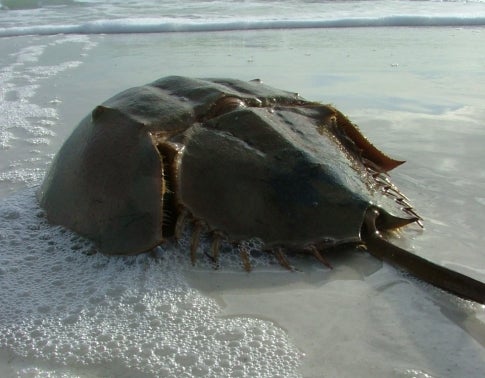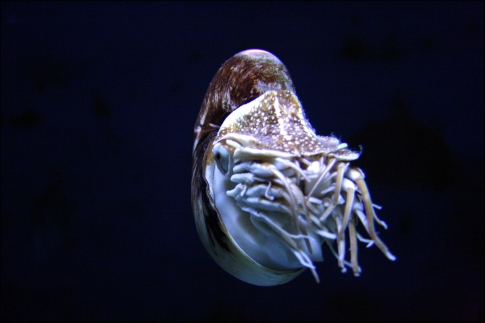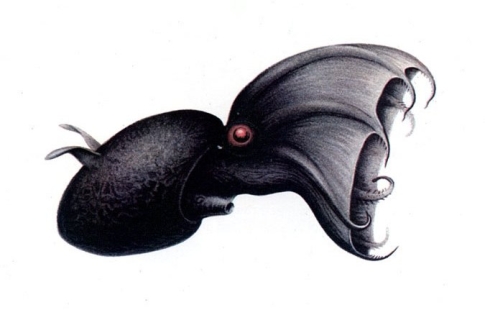The term “living fossil” is an imperfect concept, which has caused much consternation among paleontologists and biologists as they have sifted through the fossil record over time. It is meant to describe an organism that has remained relatively unchanged over millions of years, or one that has no, or very few, close surviving relatives. The concept is an informal window into the past, a way for us to consider species as they may have been millions of years ago by observing their modern descendents.
Creationists seize upon the phrase in its most rigid form, pointing to species that have apparently not evolved for a great deal of time as evidence that evolution does not exist. This, of course, is where the very literal definition of a living fossil gets us into trouble—no species alive today has followed a flat line of evolution since it first appeared however many millions of years ago. Not even the famed coelacanth is the same now as it was when it arrived in the fossil record 410 million years ago.
When Charles Darwin first coined the phrase, he was referring to the way in which evolution can slow to a crawl because of an environment in which competition is minimal. If a species is not constantly having to adapt to survive, it will have little need to change. Still, some scientists would rather see the term fade into the historical record like so many dodo birds, for the way it is often misapplied. So the moniker “living fossil” is a guideline at best, and a tool used against science at worst. With all those caveats in mind, then, let’s take a closer look at some of the plants and animals which have for one reason or another come to be considered living fossils.
Platypus
The recent decoding of the platypus’s genome confirms what we already knew: the platypus is one of the strangest creatures on Earth. It’s technically a mammal because it is covered in fur and produces milk, but it comes up short on the requirement that its young be born live (it is one of two mammals which lays eggs). It’s also part bird, having a sophisticated duck-like bill capable of electrosensory, underwater food detection, and part reptile: the male has a spur on its hind legs that delivers a potent venom. Quite possibly one of the earliest offshoots of the mammalian line, having diverged from reptiles 166 million years ago, the platypus lives as an important marker in the study of evolutionary biology.
Opossum
The only marsupial in North America, the opossum as we know it is in fact one of the most recent marsupials to evolve, which would seem to disqualify it from this list. But as far as the living-fossil moniker is concerned, the opossum can be included under its umbrella because it has retained many of the features of the earliest known marsupials and so bears a close relation. What is most curious about the animal—and is the source of the phrase “playing possum”—is its involuntary reaction when it’s threatened to a significant degree. The animal literally forces itself to the edge of a coma from which it is unable to awake for hours, meanwhile emitting a foul smell to discourage predators hunting for live prey.
Crocodilia
Alligators and crocodiles are perhaps the most obvious candidates for a family tree with short branches leading back to the long-dead. They are birds’ nearest living relatives, who are the most direct descendents of dinosaurs. While their basic body shape has stayed virtually unchanged over millions of years, their skulls and vertebrae have evolved to make them stronger and more agile in their present-day form. Today, there are 23 species of alligators and crocodiles, so they can hardly be held to a strict interpretation of the living fossil ideal. They are instead included because they are the only reptilian survivors of the Archosauria group, home to the dinosaurs.
Tuatara
Before the close of this century, the tuatara may lose the first half of its topical designation and become, simply, a fossil. Climate change will be responsible for raising the soil temperature in its remaining island habitats around New Zealand to the point at which female hatchlings cannot survive. After the introduction of rats to the mainland by early explorers, the tuatara’s population was set on a course toward extinction. Now its only remaining members there are in a fenced wildlife sanctuary. This cousin of both lizards and snakes is the only remaining member of an order of reptiles stretching back 200 million years. It is perhaps most curiously known for the third eye set on top of its skull, the exact function of which is largely speculative. While it is connected to the brain by a dedicated nerve, the parietal eye is covered with scales and is hidden from view soon after birth, leading some to believe it is responsible for maintaining circadian rhythms.
Okapi
The okapi is a solitary animal which exclusively populates the rainforests of the Congo. On first glance, it looks to be a cross between a zebra and a donkey, but is presently categorized as the closest living relative of the giraffe. While its body structure, apart from its short neck, appears to bear this out, chromosomal data has shown that it may in fact be more closely related to an antelope native to India. Here, then, is an example of an animal with no good fossil record (the giraffe’s is equally sparse) which has assumed the role of “living fossil” largely because the information necessary to prove the case otherwise does not exist. (It has, however, evolved one trait in common with the giraffe—a tremendously long and flexible tongue. It’s one of the few mammals with the ability to lick its own ears.)
Lamprey
Just two years ago, a lamprey fossil was discovered, which extended the animal’s reach back through 360 million years on Earth. What is most impressive about the lamprey—and perhaps most fitting, as it is certainly the most primitive vertebrate we know of—is that it managed to specialize very early on in its existence, and specialize so well that it needed very few adaptations through the four major extinction events it has so far survived. It is one of only two vertebrates to remain jawless; it never evolved fins, scales, true teeth, or limbs. And while today’s lampreys are slightly longer than those from hundreds of millions of years ago, they are very much alike in most every other respect.
Horseshoe Crab
Not to be outdone by the lamprey, the horseshoe crab is a marine creature which may have had an even longer stretch of non-adaptive time in the ocean. While undoubtedly less “primitive” than the lamprey, having compound eyes and limbs, it has nonetheless followed a similar path in that it evolved 445 million years ago to basically the same point at which we see it today. It has no close relatives—a many hundreds of millions of years-long branch on the evolutionary tree will do that to you—but is more connected to spiders and scorpions in its distant past than it is to crabs. While the animal is by no means endangered, its populations have been in decline since the 1970s and conservation efforts are at work along the Atlantic coast to stave off that eventuality.
Coelacanth
The coelacanth is the most famous and widely recognized species of “living fossil,” both because it was discovered in 1938 after having been thought to have been long extinct and because it is one of the earliest relatives of the fleshy-finned fish which ultimately evolved to become the first land-dwelling vertebrates. Somewhere between the coelacanth and us is the fabled missing link which dragged itself out of the ocean to walk on land. Unlike lampreys and horseshoe crabs, early coelacanths are notably different from the few specimens found by fisherman in recent years. However, their exact lineage is difficult to map because of the relatively scarcity of deep water fossils.
Ginkgo
While the fossil form of the ginkgo tree is identified by a different scientific name than the modern Ginkgo biloba, most researchers studying the tree consider them to be identical. If that weren’t enough to qualify the tree as a living fossil, consider that it is not just the only surviving member of its genus, family, and order, but that it is unique through to its phylum classification. Having such a lone spot on a taxonomy makes identifying the tree’s relatives especially difficult. On top of that, the ginkgo may be functionally extinct in the wild. While it is widely cultivated around the world (and can be found lining the streets of many American cities) its only known wild populations in China may in fact be very old stands planted and tended to for many hundreds of years by Chinese monks.
Nautilus
The fossil record for the Nautiloidea subclass is rich with a diversity of shell shapes and forms. To date, nearly 2500 species have been identified as having once flourished. Today, the only surviving members of the family are the six modern species of nautilus, which together have remained nearly unchanged since they first appeared. And while they lack many of the more advanced traits found in modern cephalopods, they have recently been discovered to have the capability for long-term memory, despite never having evolved the necessary brain structures. How it is that the animal developed similar neural pathways to the cephalopods’ without the same brain physiology is a mystery still to be solved. Researchers studying the puzzle hope the nautilus will answer other questions about how the more sophisticated modern cephalopod brains came to be.
Vampire Squid
Just as the horseshoe crab is not actually a crab, the vampire squid is not a squid, but a distant cousin descended from a cephalopod no longer with us, so that it occupies its own taxonomic order. And as the fossil record for coelacanths is spotty because of their deep habitat, so too is the record for the vampire squid, which makes it home at nearly 3,000 feet under the sea, a depth at which the concentration of oxygen hovers around 3 percent, the absolute limit for aerobic metabolism. Unlike squids and octopuses, it has no ink sac, but rather the ability to eject a bioluminescent mucus meant to distract predators in the near absolute darkness of its habitat. Because it lives at such extreme depths, it has evolved to survive through the least possible expenditure of energies. Whereas an octopus would ink a predator and jet away quickly, the vampire squid prefers to slink off just out of view.
Frilled Shark
The frilled shark made headlines in early 2007 when a living specimen surfaced off the coast of Japan. It was assumed the fish was sick because it otherwise would have been loath to leave its natural habitat at depths approaching 3,000 feet. It died after only a few hours, having been transferred to a nearby marine park, but the brief time it was observed alive was exceptionally valuable to researchers because it is such a rare being. The frilled shark is perhaps the most primitive shark known to exist. It looks very unlike a shark, with an eel-like body and proportionally small fins. Teeth in the fossil record have shown the modern frilled shark to be strikingly similar to its forebears. That’s again the result of living in an environment with little changing competition. It has had no need to evolve over the past 100 million years and so has largely remained the same.












